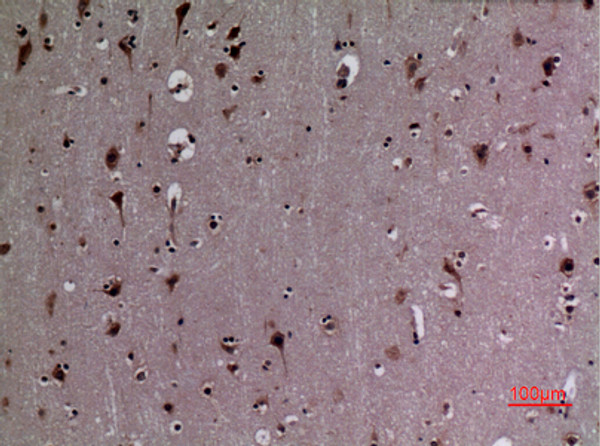| Host: | Rabbit |
| Applications: | WB/IHC/IF/ELISA |
| Reactivity: | Human/Mouse/Rat |
| Note: | STRICTLY FOR FURTHER SCIENTIFIC RESEARCH USE ONLY (RUO). MUST NOT TO BE USED IN DIAGNOSTIC OR THERAPEUTIC APPLICATIONS. |
| Short Description : | Rabbit polyclonal antibody anti-Acetyl-Heat shock protein HSP 90-alpha-Lys292/284 (251-300 aa) is suitable for use in Western Blot, Immunohistochemistry, Immunofluorescence and ELISA research applications. |
| Clonality : | Polyclonal |
| Conjugation: | Unconjugated |
| Isotype: | IgG |
| Formulation: | Liquid in PBS containing 50% Glycerol, 0.5% BSA and 0.02% Sodium Azide. |
| Purification: | The antibody was affinity-purified from rabbit antiserum by affinity-chromatography using epitope-specific immunogen. |
| Concentration: | 1 mg/mL |
| Dilution Range: | WB 1:500-1:2000IHC-P 1:100-300ELISA 1:20000IF 1:50-200 |
| Storage Instruction: | Store at-20°C for up to 1 year from the date of receipt, and avoid repeat freeze-thaw cycles. |
| Gene Symbol: | HSP90AA1 |
| Gene ID: | 3320 |
| Uniprot ID: | HS90A_HUMAN |
| Immunogen Region: | 251-300 aa |
| Specificity: | Acetyl-HSP 90 (K292/284) Polyclonal Antibody detects endogenous levels of HSP 90 protein only when acetylated at K292/284. |
| Immunogen: | The antiserum was produced against synthesized Acetyl-peptide derived from the human HSP90A/B around the Acetylation site of Lys292/284 at the amino acid range 251-300 |
| Function | Molecular chaperone that promotes the maturation, structural maintenance and proper regulation of specific target proteins involved for instance in cell cycle control and signal transduction. Undergoes a functional cycle that is linked to its ATPase activity which is essential for its chaperone activity. This cycle probably induces conformational changes in the client proteins, thereby causing their activation. Interacts dynamically with various co-chaperones that modulate its substrate recognition, ATPase cycle and chaperone function. Engages with a range of client protein classes via its interaction with various co-chaperone proteins or complexes, that act as adapters, simultaneously able to interact with the specific client and the central chaperone itself. Recruitment of ATP and co-chaperone followed by client protein forms a functional chaperone. After the completion of the chaperoning process, properly folded client protein and co-chaperone leave HSP90 in an ADP-bound partially open conformation and finally, ADP is released from HSP90 which acquires an open conformation for the next cycle. Plays a critical role in mitochondrial import, delivers preproteins to the mitochondrial import receptor TOMM70. Apart from its chaperone activity, it also plays a role in the regulation of the transcription machinery. HSP90 and its co-chaperones modulate transcription at least at three different levels. In the first place, they alter the steady-state levels of certain transcription factors in response to various physiological cues. Second, they modulate the activity of certain epigenetic modifiers, such as histone deacetylases or DNA methyl transferases, and thereby respond to the change in the environment. Third, they participate in the eviction of histones from the promoter region of certain genes and thereby turn on gene expression. Binds bacterial lipopolysaccharide (LPS) and mediates LPS-induced inflammatory response, including TNF secretion by monocytes. Antagonizes STUB1-mediated inhibition of TGF-beta signaling via inhibition of STUB1-mediated SMAD3 ubiquitination and degradation. Mediates the association of TOMM70 with IRF3 or TBK1 in mitochondrial outer membrane which promotes host antiviral response. (Microbial infection) Seems to interfere with N.meningitidis NadA-mediated invasion of human cells. Decreasing HSP90 levels increases adhesion and entry of E.coli expressing NadA into human Chang cells.increasing its levels leads to decreased adhesion and invasion. |
| Protein Name | Heat Shock Protein Hsp 90-AlphaHeat Shock 86 KdaHsp 86Hsp86Heat Shock Protein Family C Member 1Lipopolysaccharide-Associated Protein 2Lap-2Lps-Associated Protein 2Renal Carcinoma Antigen Ny-Ren-38 |
| Database Links | Reactome: R-HSA-1227986Reactome: R-HSA-1236382Reactome: R-HSA-1474151Reactome: R-HSA-168928Reactome: R-HSA-192905Reactome: R-HSA-2029482Reactome: R-HSA-203615Reactome: R-HSA-2565942Reactome: R-HSA-3000484Reactome: R-HSA-3371497Reactome: R-HSA-3371511Reactome: R-HSA-3371568Reactome: R-HSA-3371571Reactome: R-HSA-380259Reactome: R-HSA-380270Reactome: R-HSA-380284Reactome: R-HSA-380320Reactome: R-HSA-399954Reactome: R-HSA-4420097Reactome: R-HSA-5218920Reactome: R-HSA-5336415Reactome: R-HSA-5601884Reactome: R-HSA-5620912Reactome: R-HSA-5637810Reactome: R-HSA-5675482Reactome: R-HSA-6785807Reactome: R-HSA-6798695Reactome: R-HSA-8852276Reactome: R-HSA-8854518Reactome: R-HSA-8863795Reactome: R-HSA-8939211Reactome: R-HSA-9009391Reactome: R-HSA-9013418Reactome: R-HSA-9018519Reactome: R-HSA-9613829Reactome: R-HSA-9634285Reactome: R-HSA-9646399Reactome: R-HSA-9652282Reactome: R-HSA-9664565Reactome: R-HSA-9665233Reactome: R-HSA-9665244Reactome: R-HSA-9665245Reactome: R-HSA-9665246Reactome: R-HSA-9665247Reactome: R-HSA-9665249Reactome: R-HSA-9665250Reactome: R-HSA-9665251Reactome: R-HSA-9665348Reactome: R-HSA-9665686Reactome: R-HSA-9665737Reactome: R-HSA-9679191Reactome: R-HSA-9705671Reactome: R-HSA-9820962Reactome: R-HSA-9834752 |
| Cellular Localisation | NucleusCytoplasmMelanosomeCell MembraneMitochondrionIdentified By Mass Spectrometry In Melanosome Fractions From Stage I To Stage Iv |
| Alternative Antibody Names | Anti-Heat Shock Protein Hsp 90-Alpha antibodyAnti-Heat Shock 86 Kda antibodyAnti-Hsp 86 antibodyAnti-Hsp86 antibodyAnti-Heat Shock Protein Family C Member 1 antibodyAnti-Lipopolysaccharide-Associated Protein 2 antibodyAnti-Lap-2 antibodyAnti-Lps-Associated Protein 2 antibodyAnti-Renal Carcinoma Antigen Ny-Ren-38 antibodyAnti-HSP90AA1 antibodyAnti-HSP90A antibodyAnti-HSPC1 antibodyAnti-HSPCA antibody |
Information sourced from Uniprot.org















